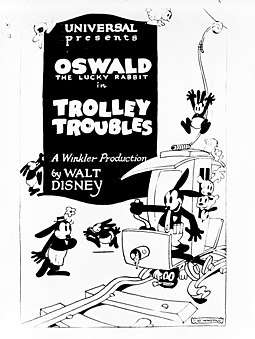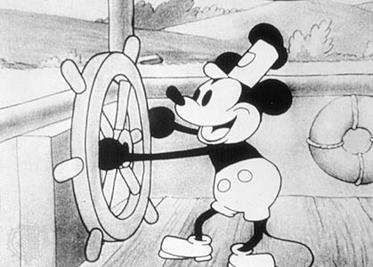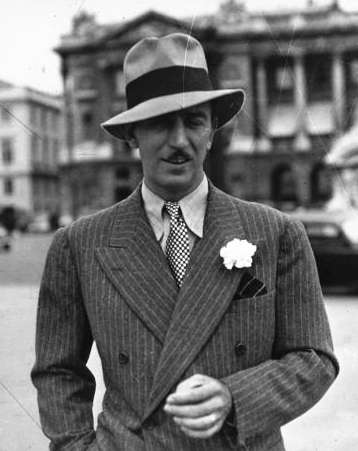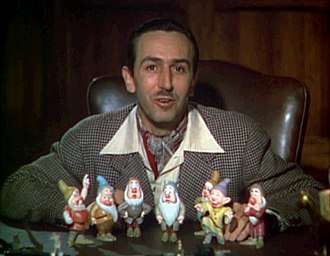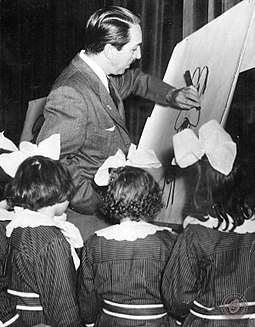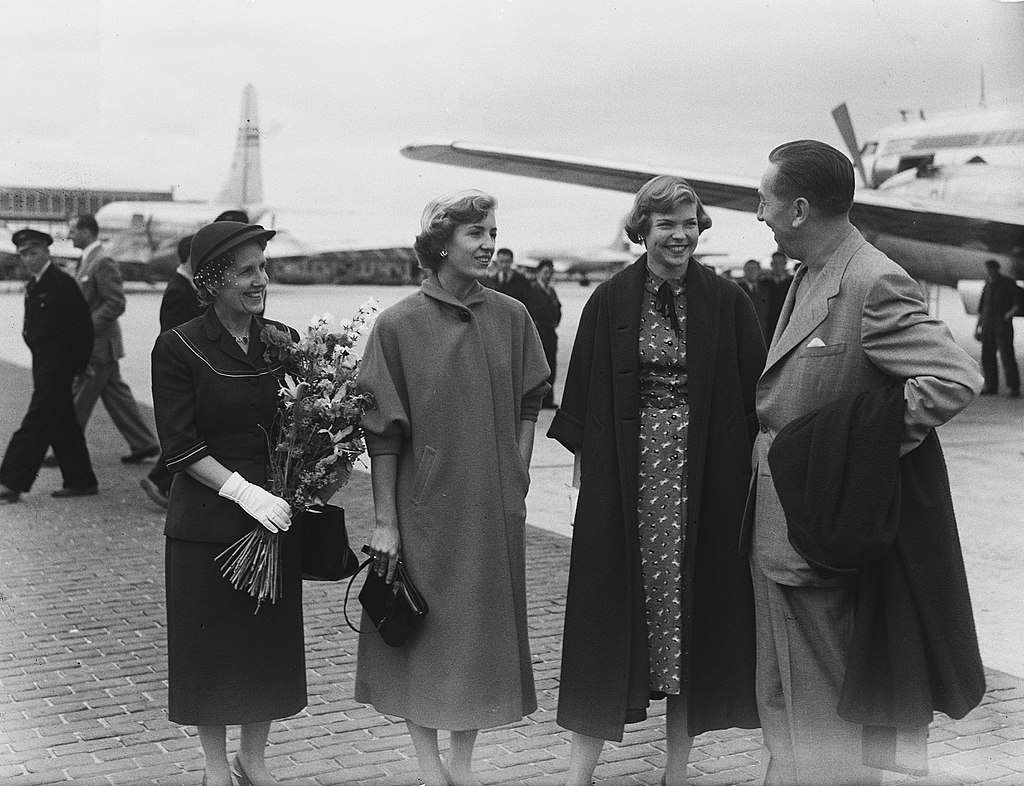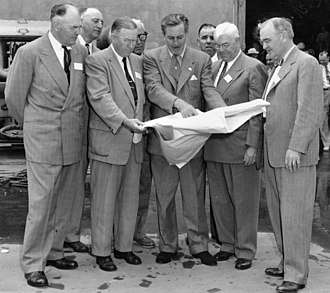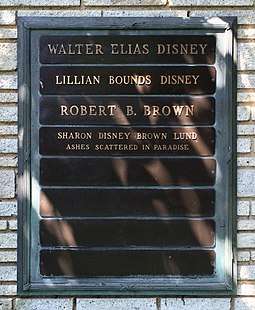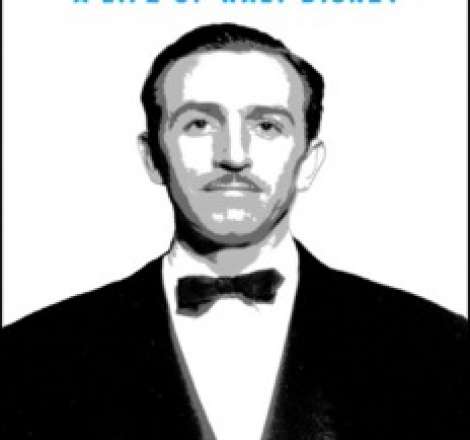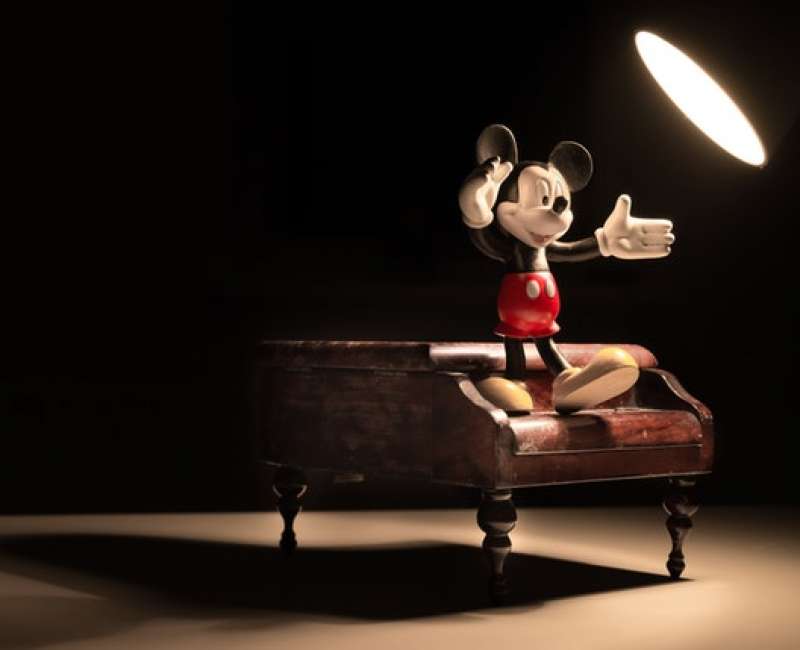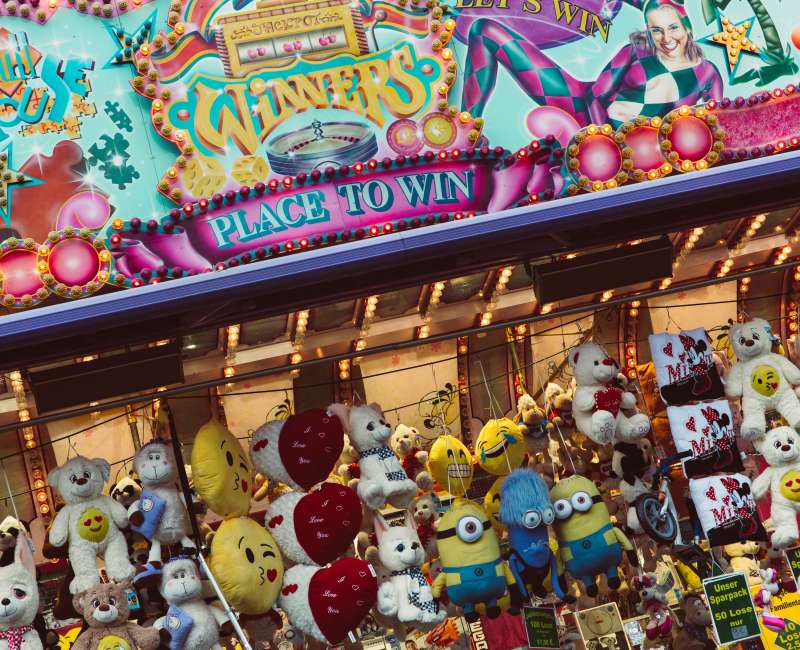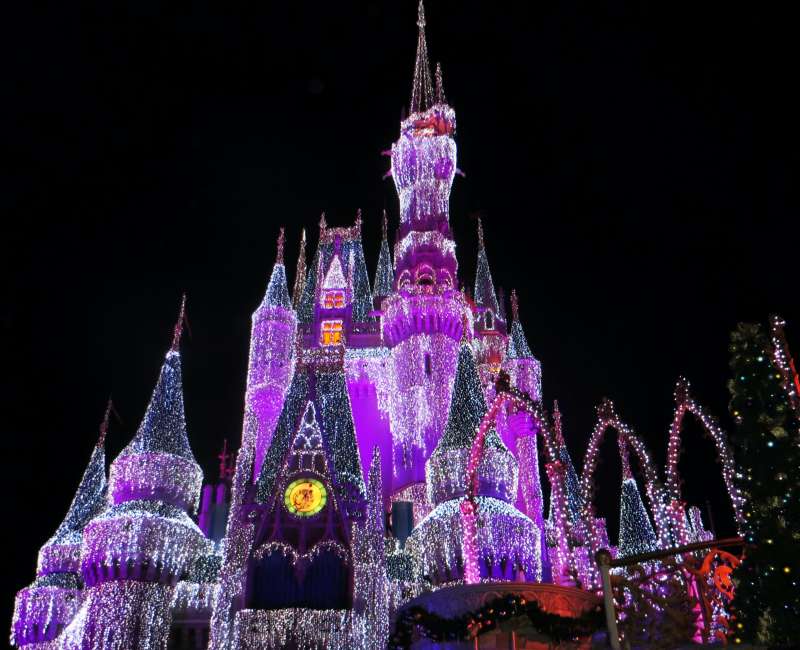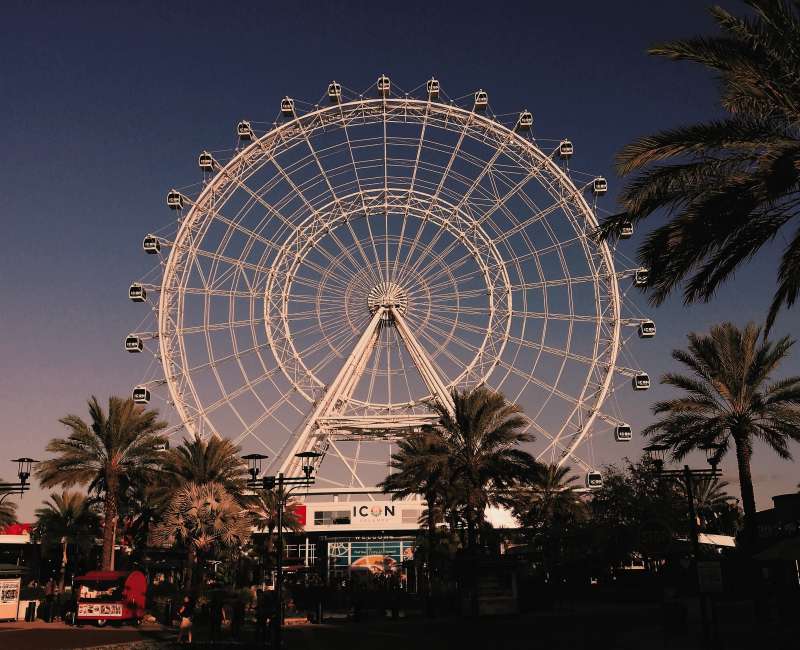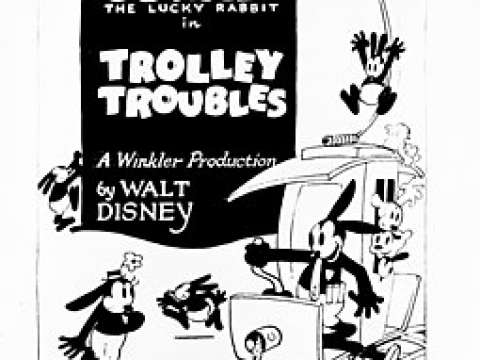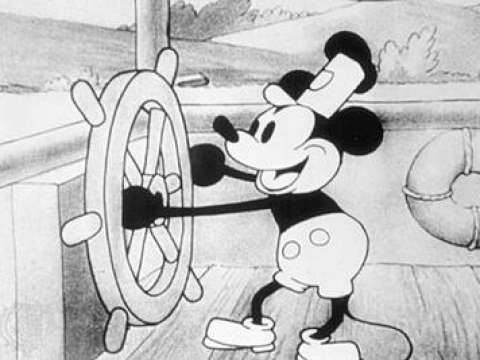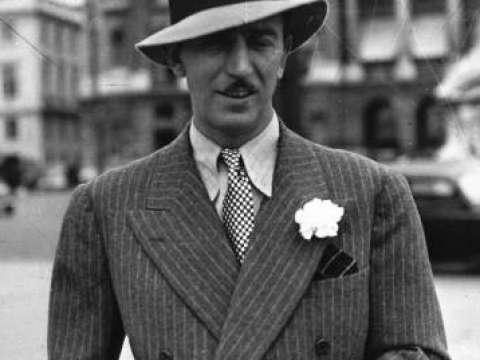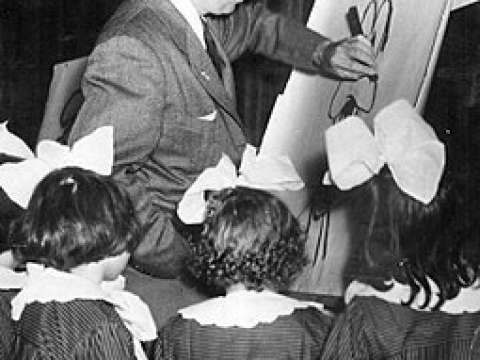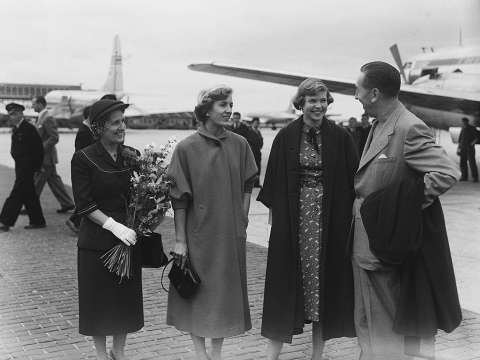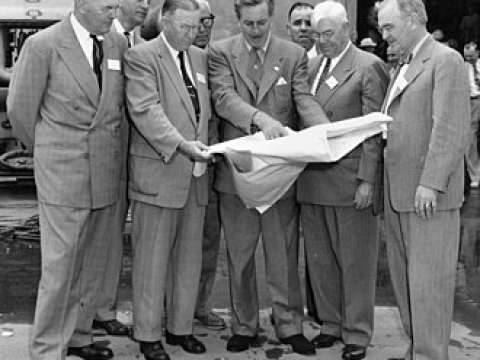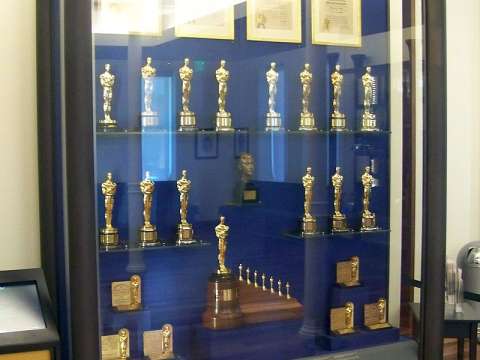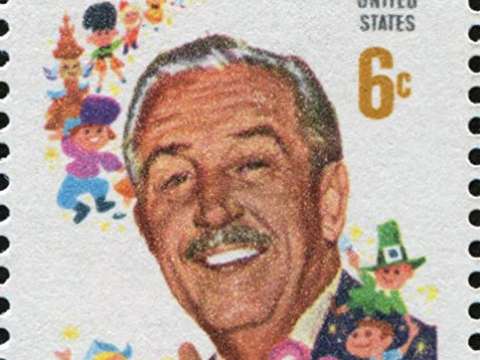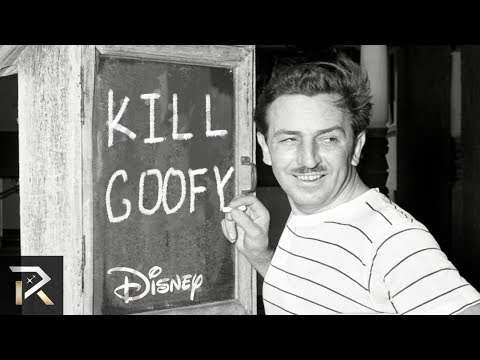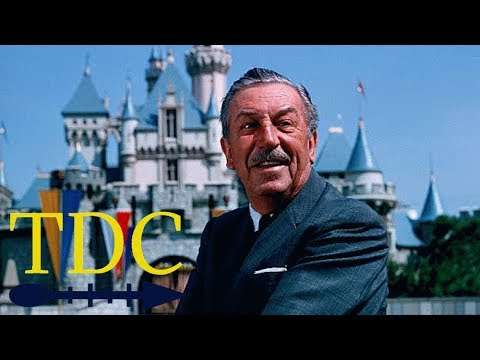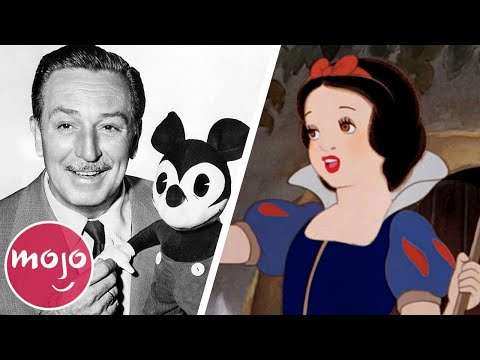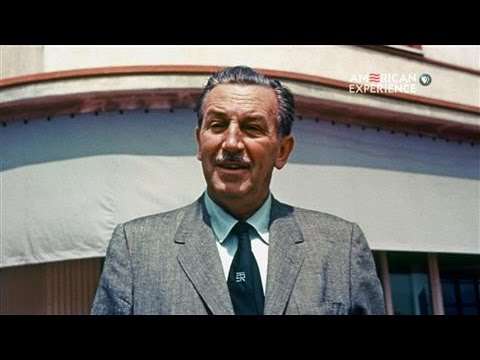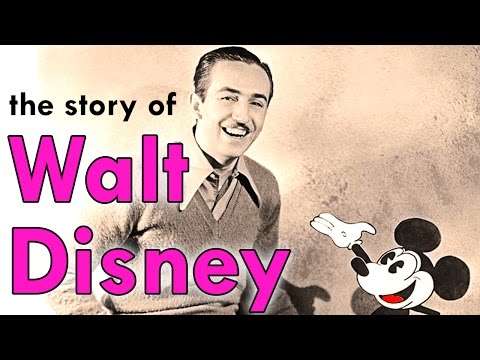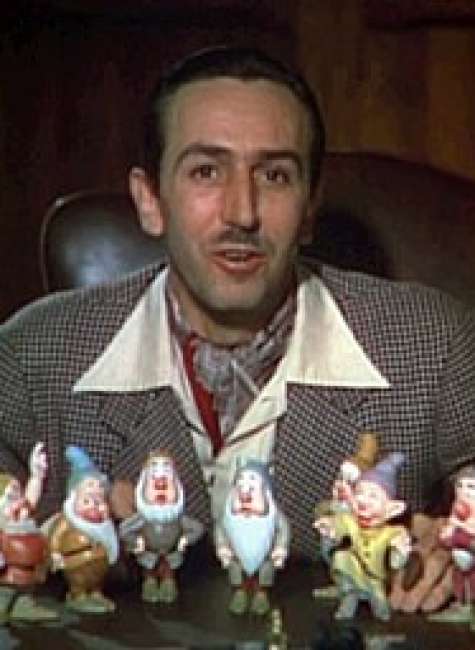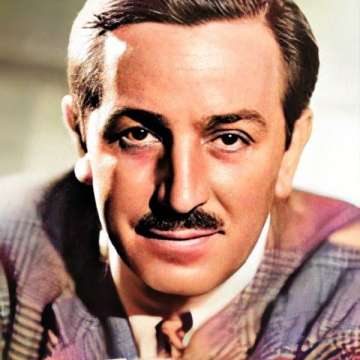

Walt Disney (1901-1966)
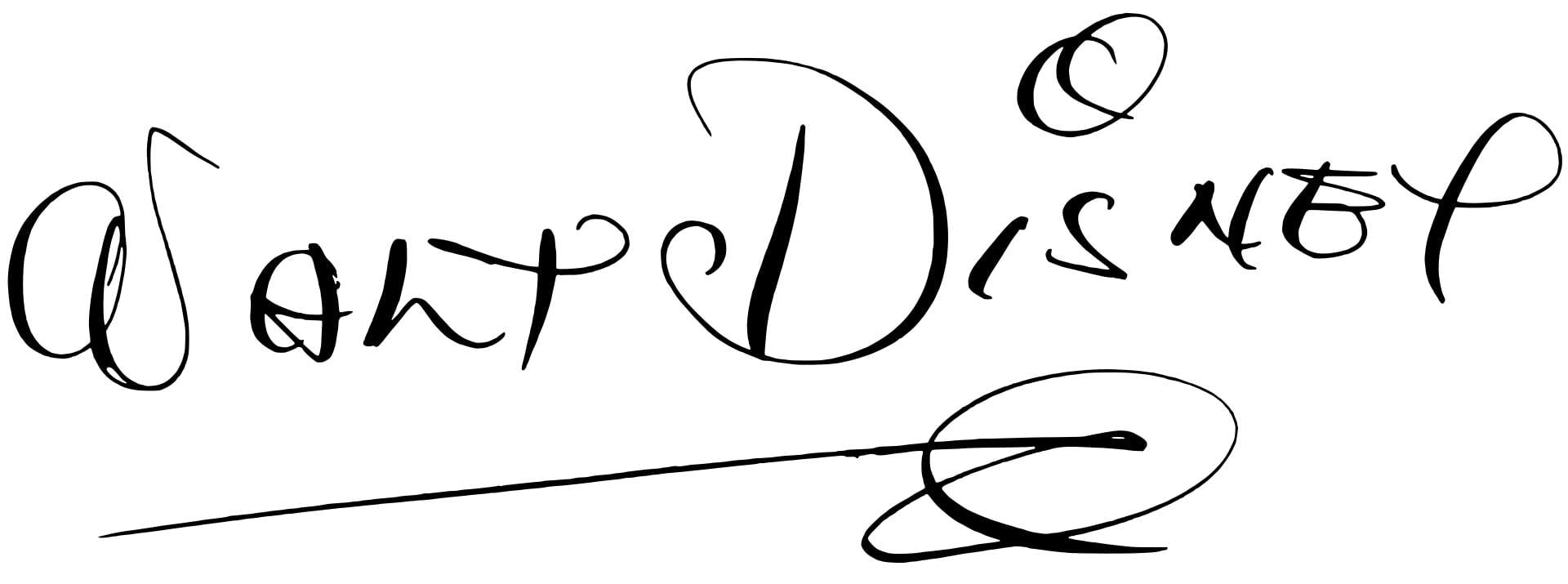
All your dreams can come true if you have the courage to pursue them.
Walter Elias Disney was an American entrepreneur, animator, writer, voice actor and film producer. A pioneer of the American animation industry, he introduced several developments in the production of cartoons. As a film producer, Disney holds the record for most Academy Awards earned by an individual, having won 22 Oscars from 59 nominations. He was presented with two Golden Globe Special Achievement Awards and an Emmy Award, among other honors. Several of his films are included in the National Film Registry by the Library of Congress.
Born in Chicago in 1901, Disney developed an early interest in drawing. He took art classes as a boy and got a job as a commercial illustrator at the age of 18. He moved to California in the early 1920s and set up the Disney Brothers Studio with his brother Roy. With Ub Iwerks, Walt developed the character Mickey Mouse in 1928, his first highly popular success; he also provided the voice for his creation in the early years. As the studio grew, Disney became more adventurous, introducing synchronized sound, full-color three-strip Technicolor, feature-length cartoons and technical developments in cameras. The results, seen in features such as Snow White and the Seven Dwarfs 1937, Pinocchio, Fantasia both 1940, Dumbo 1941, and Bambi 1942, furthered the development of animated film. New animated and live-action films followed after World War II, including the critically successful Cinderella 1950 and Mary Poppins 1964, the latter of which received five Academy Awards.
In the 1950s, Disney expanded into the amusement park industry, and in 1955 he opened Disneyland in Anaheim, California. To fund the project he diversified into television programs, such as Walt Disney's Disneyland and The Mickey Mouse Club; he was also involved in planning the 1959 Moscow Fair, the 1960 Winter Olympics, and the 1964 New York World's Fair. In 1965, he began development of another theme park, Disney World, the heart of which was to be a new type of city, the "Experimental Prototype Community of Tomorrow" EPCOT. Disney was a heavy smoker throughout his life and died of lung cancer in December 1966 before either the park or the EPCOT project were completed.
Disney was a shy, self-deprecating and insecure man in private but adopted a warm and outgoing public persona. He had high standards and high expectations of those with whom he worked. Although there have been accusations that he was racist or anti-Semitic, they have been contradicted by many who knew him. His reputation changed in the years after his death, from a purveyor of homely patriotic values to a representative of American imperialism. He nevertheless remains an important figure in the history of animation and in the cultural history of the United States, where he is considered a national cultural icon. His film work continues to be shown and adapted; his namesake studio and company maintains high standards in its production of popular entertainment, and the Disney amusement parks have grown in size and number to attract visitors in several countries.
Biography
Early life: 1901–1920
Walt Disney was born on December 5, 1901, at 1249 Tripp Avenue, in Chicago's Hermosa neighborhood. He was the fourth son of Elias Disney—born in the Province of Canada, to Irish parents—and Flora née Call, an American of German and English descent. Aside from Walt, Elias and Flora's sons were Herbert, Raymond and Roy; the couple had a fifth child, Ruth, in December 1903. In 1906, when Disney was four, the family moved to a farm in Marceline, Missouri, where his uncle Robert had just purchased land. In Marceline, Disney developed his interest in drawing when he was paid to draw the horse of a retired neighborhood doctor. Elias was a subscriber to the Appeal to Reason newspaper, and Disney practiced drawing by copying the front-page cartoons of Ryan Walker. Disney also began to develop an ability to work with watercolors and crayons. He lived near the Atchison, Topeka and Santa Fe Railway line and became enamored with trains. He and his younger sister Ruth started school at the same time at the Park School in Marceline in late 1909.

In 1911, the Disneys moved to Kansas City, Missouri. There, Disney attended the Benton Grammar School, where he met fellow-student Walter Pfeiffer, who came from a family of theatre fans and introduced Disney to the world of vaudeville and motion pictures. Before long, he was spending more time at the Pfeiffers' house than at home. Elias had purchased a newspaper delivery route for The Kansas City Star and Kansas City Times. Disney and his brother Roy woke up at 4:30 every morning to deliver the Times before school and repeated the round for the evening Star after school. The schedule was exhausting, and Disney often received poor grades after falling asleep in class, but he continued his paper route for more than six years. He attended Saturday courses at the Kansas City Art Institute and also took a correspondence course in cartooning.
In 1917, Elias bought stock in a Chicago jelly producer, the O-Zell Company, and moved back to the city with his family. Disney enrolled at McKinley High School and became the cartoonist of the school newspaper, drawing patriotic pictures about World War I; he also took night courses at the Chicago Academy of Fine Arts. In mid-1918, Disney attempted to join the United States Army to fight against the Germans, but he was rejected for being too young. After forging the date of birth on his birth certificate, he joined the Red Cross in September 1918 as an ambulance driver. He was shipped to France but arrived in November, after the armistice. He drew cartoons on the side of his ambulance for decoration and had some of his work published in the army newspaper Stars and Stripes. Disney returned to Kansas City in October 1919, where he worked as an apprentice artist at the Pesmen-Rubin Commercial Art Studio. There, he drew commercial illustrations for advertising, theater programs and catalogs. He also befriended fellow artist Ub Iwerks.
Early career: 1920–1928
In January 1920, as Pesmen-Rubin's revenue declined after Christmas, Disney and Iwerks were laid off. They started their own business, the short-lived Iwerks-Disney Commercial Artists. Failing to attract many customers, Disney and Iwerks agreed that Disney should leave temporarily to earn money at the Kansas City Film Ad Company, run by A. V. Cauger; the following month Iwerks, who was not able to run their business alone, also joined. The company produced commercials using the cutout animation technique. Disney became interested in animation, although he preferred drawn cartoons such as Mutt and Jeff and Koko the Clown. With the assistance of a borrowed book on animation and a camera, he began experimenting at home. He came to the conclusion that cel animation was more promising than the cutout method. Unable to persuade Cauger to try cel animation at the company, Disney opened a new business with a co-worker from the Film Ad Co, Fred Harman. Their main client was the local Newman Theater, and the short cartoons they produced were sold as "Newman's Laugh-O-Grams". Disney studied Paul Terry's Aesop's Fables as a model, and the first six "Laugh-O-Grams" were modernized fairy tales.
In May 1921, the success of the "Laugh-O-Grams" led to the establishment of Laugh-O-Gram Studio, for which he hired more animators, including Fred Harman's brother Hugh, Rudolf Ising and Iwerks. The Laugh-O-Grams cartoons did not provide enough income to keep the company solvent, so Disney started production of Alice's Wonderland—based on Alice's Adventures in Wonderland—which combined live action with animation; he cast Virginia Davis in the title role. The result, a 12-and-a-half-minute, one-reel film, was completed too late to save Laugh-O-Gram Studio, which went into bankruptcy in 1923.
Disney moved to Hollywood in July 1923. Although New York was the center of the cartoon industry, he was attracted to Los Angeles because his brother Roy was convalescing from tuberculosis there, and he hoped to become a live-action film director. Disney's efforts to sell Alice's Wonderland were in vain until he heard from New York film distributor Margaret J. Winkler. She was losing the rights to both the Out of the Inkwell and Felix the Cat cartoons, and needed a new series. In October, they signed a contract for six Alice comedies, with an option for two further series of six episodes each. Disney and his brother Roy formed the Disney Brothers Studio—which later became The Walt Disney Company—to produce the films; they persuaded Davis and her family to relocate to Hollywood to continue production, with Davis on contract at $100 a month. In July 1924, Disney also hired Iwerks, persuading him to relocate to Hollywood from Kansas City.

Early in 1925, Disney hired an ink artist, Lillian Bounds. They married in July of that year, at her brother's house in her hometown of Lewiston, Idaho. The marriage was generally happy, according to Lillian, although according to Disney's biographer Neal Gabler she did not "accept Walt's decisions meekly or his status unquestionably, and she admitted that he was always telling people 'how henpecked he is'." Lillian had little interest in films or the Hollywood social scene and she was, in the words of the historian Steven Watts, "content with household management and providing support for her husband". Their marriage produced two daughters, Diane born December 1933 and Sharon adopted in December 1936, born six weeks previously. Within the family, neither Disney nor his wife hid the fact Sharon had been adopted, although they became annoyed if people outside the family raised the point. The Disneys were careful to keep their daughters out of the public eye as much as possible, particularly in the light of the Lindbergh kidnapping; Disney took steps to ensure his daughters were not photographed by the press.
By 1926 Winkler's role in the distribution of the Alice series had been handed over to her husband, the film producer Charles Mintz, although the relationship between him and Disney was sometimes strained. The series ran until July 1927, by which time Disney had begun to tire of it and wanted to move away from the mixed format to all animation. After Mintz requested new material to distribute through Universal Pictures, Disney and Iwerks created Oswald the Lucky Rabbit, a character Disney wanted to be "peppy, alert, saucy and venturesome, keeping him also neat and trim".
In February 1928, Disney hoped to negotiate a larger fee for producing the Oswald series, but found Mintz wanting to reduce the payments. Mintz had also persuaded many of the artists involved to work directly for him, including Harman, Ising, Carman Maxwell and Friz Freleng. Disney also found out that Universal owned the intellectual property rights to Oswald. Mintz threatened to start his own studio and produce the series himself if Disney refused to accept the reductions. Disney declined Mintz's ultimatum and lost most of his animation staff, except Iwerks, who chose to remain with him.
Creation of Mickey Mouse to the first Academy Awards: 1928–1933
To replace Oswald, Disney and Iwerks developed Mickey Mouse, possibly inspired by a pet mouse that Disney had adopted while working in his Laugh-O-Gram studio, although the origins of the character are unclear. Disney's original choice of name was Mortimer Mouse, but Lillian thought it too pompous, and suggested Mickey instead. Iwerks revised Disney's provisional sketches to make the character easier to animate. Disney, who had begun to distance himself from the animation process, provided Mickey's voice until 1947. In the words of one Disney employee, "Ub designed Mickey's physical appearance, but Walt gave him his soul."
Mickey Mouse first appeared in May 1928 as a single test screening of the short Plane Crazy, but it, and the second feature, The Gallopin' Gaucho, failed to find a distributor. Following the 1927 sensation The Jazz Singer, Disney used synchronized sound on the third short, Steamboat Willie, to create the first post-produced sound cartoon. After the animation was complete, Disney signed a contract with the former executive of Universal Pictures, Pat Powers, to use the "Powers Cinephone" recording system; Cinephone became the new distributor for Disney's early sound cartoons, which soon became popular.

To improve the quality of the music, Disney hired the professional composer and arranger Carl Stalling, on whose suggestion the Silly Symphony series was developed, providing stories through the use of music; the first in the series, The Skeleton Dance 1929, was drawn and animated entirely by Iwerks. Also hired at this time were several local artists, some of whom stayed with the company as core animators; the group later became known as the Nine Old Men. Both the Mickey Mouse and Silly Symphonies series were successful, but Disney and his brother felt they were not receiving their rightful share of profits from Powers. In 1930, Disney tried to trim costs from the process by urging Iwerks to abandon the practice of animating every separate cel in favor of the more efficient technique of drawing key poses and letting lower-paid assistants sketch the inbetween poses. Disney asked Powers for an increase in payments for the cartoons. Powers refused and signed Iwerks to work for him; Stalling resigned shortly afterwards, thinking that without Iwerks, the Disney Studio would close. Disney had a nervous breakdown in October 1931—which he blamed on the machinations of Powers and his own overwork—so he and Lillian took an extended holiday to Cuba and a cruise to Panama to recover.
With the loss of Powers as distributor, Disney studios signed a contract with Columbia Pictures to distribute the Mickey Mouse cartoons, which became increasingly popular, including internationally. Disney, always keen to embrace new technology, filmed Flowers and Trees 1932 in full-color three-strip Technicolor; he was also able to negotiate a deal giving him the sole right to use the three-strip process until August 31, 1935. All subsequent Silly Symphony cartoons were in color. Flowers and Trees was popular with audiences and won the Academy Award for best Short Subject Cartoon at the 1932 ceremony. Disney had been nominated for another film in that category, Mickey's Orphans, and received an Honorary Award "for the creation of Mickey Mouse".

In 1933, Disney produced The Three Little Pigs, a film described by the media historian Adrian Danks as "the most successful short animation of all time". The film won Disney another Academy Award in the Short Subject Cartoon category. The film's success led to a further increase in the studio's staff, which numbered nearly 200 by the end of the year. Disney realized the importance of telling emotionally gripping stories that would interest the audience, and he invested in a "story department" separate from the animators, with storyboard artists who would detail the plots of Disney's films.
Golden age of animation: 1934–1941
By 1934, Disney had become dissatisfied with producing formulaic cartoon shorts, and believed a feature-length cartoon would be more profitable. The studio began the four-year production of Snow White and the Seven Dwarfs, based on the fairy tale. When news leaked out about the project, many in the film industry predicted it would bankrupt the company; industry insiders nicknamed it "Disney's Folly". The film, which was the first animated feature made in full color and sound, cost $1.5 million to produce—three times over budget. To ensure the animation was as realistic as possible, Disney sent his animators on courses at the Chouinard Art Institute; he brought animals into the studio and hired actors so that the animators could study realistic movement. To portray the changing perspective of the background as a camera moved through a scene, Disney's animators developed a multiplane camera which allowed drawings on pieces of glass to be set at various distances from the camera, creating an illusion of depth. The glass could be moved to create the impression of a camera passing through the scene. The first work created on the camera—a Silly Symphony called The Old Mill 1937—won the Academy Award for Animated Short Film because of its impressive visual power. Although Snow White had been largely finished by the time the multiplane camera had been completed, Disney ordered some scenes be re-drawn to use the new effects.
Snow White premiered in December 1937 to high praise from critics and audiences. The film became the most successful motion picture of 1938 and by May 1939 its total gross of $6.5 million made it the most successful sound film made to that date. Disney won another Honorary Academy Award, which consisted of one full-sized and seven miniature Oscar statuettes. The success of Snow White heralded one of the most productive eras for the studio; the Walt Disney Family Museum calls the following years "the 'Golden Age of Animation' ". With work on Snow White finished, the studio began producing Pinocchio in early 1938 and Fantasia in November of the same year. Both films were released in 1940, and neither performed well at the box office—partly because revenues from Europe had dropped following the start of World War II in 1939. The studio made a loss on both pictures and was deeply in debt by the end of February 1941.

In response to the financial crisis, Disney and his brother Roy started the company's first public stock offering in 1940, and implemented heavy salary cuts. The latter measure, and Disney's sometimes high-handed and insensitive manner of dealing with staff, led to a 1941 animators' strike which lasted five weeks. While a federal mediator from the National Labor Relations Board negotiated with the two sides, Disney accepted an offer from the Office of the Coordinator of Inter-American Affairs to make a goodwill trip to South America, ensuring he was absent during a resolution he knew would be unfavorable to the studio. As a result of the strike—and the financial state of the company—several animators left the studio, and Disney's relationship with other members of staff was permanently strained as a result. The strike temporarily interrupted the studio's next production, Dumbo 1941, which Disney produced in a simple and inexpensive manner; the film received a positive reaction from audiences and critics alike.
World War II and beyond: 1941–1950
Shortly after the release of Dumbo in October 1941, the U.S. entered World War II. Disney formed the Walt Disney Training Films Unit within the company to produce instruction films for the military such as Four Methods of Flush Riveting and Aircraft Production Methods. Disney also met with Henry Morgenthau Jr., the Secretary of the Treasury, and agreed to produce short Donald Duck cartoons to promote war bonds. Disney also produced several propaganda productions, including shorts such as Der Fuehrer's Face—which won an Academy Award—and the 1943 feature film Victory Through Air Power.
The military films generated only enough revenue to cover costs, and the feature film Bambi—which had been in production since 1937—underperformed on its release in April 1942, and lost $200,000 at the box office. On top of the low earnings from Pinocchio and Fantasia, the company had debts of $4 million with the Bank of America in 1944. At a meeting with Bank of America executives to discuss the future of the company, the bank's chairman and founder, Amadeo Giannini, told his executives, "I've been watching the Disneys' pictures quite closely because I knew we were lending them money far above the financial risk. ... They're good this year, they're good next year, and they're good the year after. ... You have to relax and give them time to market their product." Disney's production of short films decreased in the late 1940s, coinciding with increasing competition in the animation market from Warner Bros. and Metro-Goldwyn-Mayer. Roy Disney, for financial reasons, suggested more combined animation and live-action productions. In 1948, Disney initiated a series of popular live-action nature films, titled True-Life Adventures, with Seal Island the first; the film won the Academy Award in the Best Short Subject Two-Reel category.

Disney grew more politically conservative as he got older. A Democratic Party supporter until the 1940 presidential election, when he switched allegiance to the Republican Party, he became a generous donor to Thomas E. Dewey's 1944 bid for the presidency. In 1946, he was a founding member of the Motion Picture Alliance for the Preservation of American Ideals, an organization who stated they "believ in, and like, the American Way of Life ... we find ourselves in sharp revolt against a rising tide of Communism, Fascism and kindred beliefs, that seek by subversive means to undermine and change this way of life". In 1947, during the Second Red Scare, Disney testified before the House Un-American Activities Committee HUAC, where he branded Herbert Sorrell, David Hilberman and William Pomerance, former animators and labor union organizers, as communist agitators; Disney stated that the 1941 strike led by them was part of an organized communist effort to gain influence in Hollywood. It was alleged by The New York Times in 1993 that Disney had been passing secret information to the FBI from 1940 until his death in 1966. In return for this information, J. Edgar Hoover allowed Disney to film in FBI headquarters in Washington. Disney was made a "full Special Agent in Charge Contact" in 1954.
In 1949, Disney and his family moved to a new home in the Holmby Hills district of Los Angeles. With the help of his friends Ward and Betty Kimball, who already had their own backyard railroad, Disney developed blueprints and immediately set to work on creating a miniature live steam railroad for his backyard. The name of the railroad, Carolwood Pacific Railroad, came from his home's location on Carolwood Drive. The miniature working steam locomotive was built by Disney Studios engineer Roger E. Broggie, and Disney named it Lilly Belle after his wife; after three years Disney ordered it into storage due to a series of accidents involving his guests.
Theme parks, television and other interests: 1950–1966
In early 1950, Disney produced Cinderella, his studio's first animated feature in eight years. It was popular with critics and theater audiences. Costing $2.2 million to produce, it earned nearly $8 million in its first year. Disney was less involved than he had been with previous pictures because of his involvement in his first entirely live-action feature, Treasure Island 1950, which was shot in Britain, as was The Story of Robin Hood and His Merrie Men 1952. Other all-live-action features followed, many of which had patriotic themes. He continued to produce full-length animated features too, including Alice in Wonderland 1951 and Peter Pan 1953. From the early to mid-1950s, Disney began to devote less attention to the animation department, entrusting most of its operations to his key animators, the Nine Old Men, although he was always present at story meetings. Instead, he started concentrating on other ventures.
For several years Disney had been considering building a theme park. When he visited Griffith Park in Los Angeles with his daughters, he wanted to be in a clean, unspoiled park, where both children and their parents could have fun. He visited the Tivoli Gardens in Copenhagen, Denmark, and was heavily influenced by the cleanliness and layout of the park. In March 1952 he received zoning permission to build a theme park in Burbank, near the Disney studios. This site proved too small, and a larger plot in Anaheim, 35 miles 56 km south of the studio, was purchased. To distance the project from the studio—which might attract the criticism of shareholders—Disney formed WED Enterprises now Walt Disney Imagineering and used his own money to fund a group of designers and animators to work on the plans; those involved became known as "Imagineers". After obtaining bank funding he invited other stockholders, American Broadcasting-Paramount Theatres—part of American Broadcasting Company ABC—and Western Printing and Lithographing Company. In mid-1954, Disney sent his Imagineers to every amusement park in the U.S. to analyze what worked and what pitfalls or problems there were in the various locations and incorporated their findings into his design. Construction work started in July 1954, and Disneyland opened in July 1955; the opening ceremony was broadcast on ABC, which reached 70 million viewers. The park was designed as a series of themed lands, linked by the central Main Street, U.S.A.—a replica of the main street in his hometown of Marceline. The connected themed areas were Adventureland, Frontierland, Fantasyland and Tomorrowland. The park also contained the narrow gauge Disneyland Railroad that linked the lands; around the outside of the park was a high berm to separate the park from the outside world. An editorial in The New York Times considered that Disney had "tastefully combined some of the pleasant things of yesterday with fantasy and dreams of tomorrow". Although there were early minor problems with the park, it was a success, and after a month's operation, Disneyland was receiving over 20,000 visitors a day; by the end of its first year, it attracted 3.6 million guests.
The money from ABC was contingent on Disney television programs. The studio had been involved in a successful television special on Christmas Day 1950 about the making of Alice in Wonderland. Roy believed the program added millions to the box office takings. In a March 1951 letter to shareholders, he wrote that "television can be a most powerful selling aid for us, as well as a source of revenue. It will probably be on this premise that we enter television when we do". In 1954, after the Disneyland funding had been agreed, ABC broadcast Walt Disney's Disneyland, an anthology consisting of animated cartoons, live-action features and other material from the studio's library. The show was successful in terms of ratings and profits, earning an audience share of over 50%. In April 1955, Newsweek called the series an "American institution". ABC was pleased with the ratings, leading to Disney's first daily television program, The Mickey Mouse Club, a variety show catering specifically to children. The program was accompanied by merchandising through various companies Western Printing, for example, had been producing coloring books and comics for over 20 years, and produced several items connected to the show. One of the segments of Disneyland consisted of the five-part miniseries Davy Crockett which, according to Gabler, "became an overnight sensation". The show's theme song, "The Ballad of Davy Crockett", became internationally popular, and ten million records were sold. As a result, Disney formed his own record production and distribution entity, Disneyland Records.

As well as the construction of Disneyland, Disney worked on other projects away from the studio. He was consultant to the 1959 American National Exhibition in Moscow; Disney Studios' contribution was America the Beautiful, a 19-minute film in the 360-degree Circarama theater that was one of the most popular attractions. The following year he acted as the chairman of the Pageantry Committee for the 1960 Winter Olympics in Squaw Valley, California, where he designed the opening, closing and medal ceremonies.
Despite the demands wrought by non-studio projects, Disney continued to work on film and television projects. In 1955, he was involved in "Man in Space", an episode of the Disneyland series, which was made in collaboration with NASA rocket designer Wernher von Braun. Disney also oversaw aspects of the full-length features Lady and the Tramp the first animated film in CinemaScope in 1955, Sleeping Beauty the first animated film in Technirama 70 mm film in 1959, One Hundred and One Dalmatians the first animated feature film to use Xerox cels in 1961, and The Sword in the Stone in 1963.
In 1964, Disney produced Mary Poppins, based on the book series by P. L. Travers; he had been trying to acquire the rights to the story since the 1940s. It became the most successful Disney film of the 1960s, although Travers disliked the film intensely and regretted having sold the rights. The same year he also became involved in plans to expand the California Institute of the Arts colloquially called CalArts, and had an architect draw up blueprints for a new building.

Disney provided four exhibits for the 1964 New York World's Fair, for which he obtained funding from selected corporate sponsors. For PepsiCo, who planned a tribute to UNICEF, Disney developed It's a Small World, a boat ride with audio-animatronic dolls depicting children of the world; Great Moments with Mr. Lincoln contained an animatronic Abraham Lincoln giving excerpts from his speeches; Carousel of Progress promoted the importance of electricity; and Ford's Magic Skyway portrayed the progress of mankind. Elements of all four exhibits—principally concepts and technology—were re-installed in Disneyland, although It's a Small World is the ride that most closely resembles the original.
During the early to mid-1960s, Disney developed plans for a ski resort in Mineral King, a glacial valley in California's Sierra Nevada. He hired experts such as the renowned Olympic ski coach and ski-area designer Willy Schaeffler. With income from Disneyland accounting for an increasing proportion of the studio's income, Disney continued to look for venues for other attractions. In late 1965, he announced plans to develop another theme park to be called "Disney World" now Walt Disney World, a few miles southwest of Orlando, Florida. Disney World was to include the "Magic Kingdom"—a larger and more elaborate version of Disneyland—plus golf courses and resort hotels. The heart of Disney World was to be the "Experimental Prototype Community of Tomorrow" EPCOT, which he described as:
During 1966, Disney cultivated businesses willing to sponsor EPCOT. He increased his involvement in the studio's films, and was heavily involved in the story development of The Jungle Book, the live-action musical feature The Happiest Millionaire both 1967 and the animated short Winnie the Pooh and the Blustery Day 1968.
Illness, death and aftermath
Disney had been a heavy smoker since World War I. He did not use cigarettes with filters and had smoked a pipe as a young man. In November 1966, he was diagnosed with lung cancer and was treated with cobalt therapy. On November 30 he felt unwell and was taken to St. Joseph Hospital where, on December 15, ten days after his 65th birthday, he died of circulatory collapse caused by the cancer. His remains were cremated two days later and his ashes interred at the Forest Lawn Memorial Park in Glendale, California.
The release of The Jungle Book and The Happiest Millionaire in 1967 raised the total number of feature films that Disney had been involved in to 81. When Winnie the Pooh and the Blustery Day was released in 1968, it earned Disney an Academy Award in the Short Subject Cartoon category, awarded posthumously. After Disney's death, his studios continued to produce live-action films prolifically but largely abandoned animation until the late 1980s, after which there was what The New York Times describes as the "Disney Renaissance" that began with The Little Mermaid 1989. Disney's companies continue to produce successful film, television and stage entertainment.

Disney's plans for the futuristic city of EPCOT did not come to fruition. After Disney's death, his brother Roy deferred his retirement to take full control of the Disney companies. He changed the focus of the project from a town to an attraction. At the inauguration in 1971, Roy dedicated Walt Disney World to his brother. Walt Disney World expanded with the opening of Epcot Center in 1982; Walt Disney's vision of a functional city was replaced by a park more akin to a permanent world's fair. In 2009, the Walt Disney Family Museum, designed by Disney's daughter Diane and her son Walter E. D. Miller, opened in the Presidio of San Francisco. Thousands of artifacts from Disney's life and career are on display, including numerous awards that he received. In 2014, the Disney theme parks around the world hosted approximately 134 million visitors.
Disney has been portrayed numerous times in fictional works. H. G. Wells references Disney in his 1938 novel The Holy Terror, in which World Dictator Rud fears that Donald Duck is meant to lampoon the dictator. Disney was portrayed by Len Cariou in the 1995 made-for-TV film A Dream Is a Wish Your Heart Makes: The Annette Funicello Story, and by Tom Hanks in the 2013 film Saving Mr. Banks. In 2001, the German author Peter Stephan Jungk published Der König von Amerika trans: The King of America, a fictional work of Disney's later years that re-imagines him as a power-hungry racist. The composer Philip Glass later adapted the book into the opera The Perfect American 2013.
Honors
Disney received 59 Academy Award nominations, including 22 awards: both totals are records. He was nominated for three Golden Globe Awards, but did not win, but he was presented with two Special Achievement Awards—for Bambi 1942 and The Living Desert 1953—and the Cecil B. DeMille Award. He also received four Emmy Award nominations, winning once, for Best Producer for the Disneyland television series. Several of his films are included in the United States National Film Registry by the Library of Congress as "culturally, historically, or aesthetically significant": Steamboat Willie, The Three Little Pigs, Snow White and the Seven Dwarfs, Fantasia, Pinocchio, Bambi, Dumbo and Mary Poppins. In 1998, the American Film Institute published a list of the 100 greatest American films, according to industry experts; the list included Snow White and the Seven Dwarfs at number 49, and Fantasia at 58.
In February 1960, Disney was inducted to the Hollywood Walk of Fame with two stars, one for motion pictures and the other for his television work; Mickey Mouse was given his own star for motion pictures in 1978. Disney was also inducted into the Television Hall of Fame in 1986, the California Hall of Fame in December 2006, and was the inaugural recipient of a star on the Anaheim walk of stars in 2014.

The Walt Disney Family Museum records that he "along with members of his staff, received more than 950 honors and citations from throughout the world". He was made a Chevalier in the French Légion d'honneur in 1935, and in 1952 he was awarded the country's highest artistic decoration, the Officer d'Academie. Other national awards include Thailand's Order of the Crown 1960; Germany's Order of Merit 1956, Brazil's Order of the Southern Cross 1941 and Mexico's Order of the Aztec Eagle 1943. In the United States, he received the Presidential Medal of Freedom on September 14, 1964, and on May 24, 1968, he was posthumously awarded the Congressional Gold Medal. He received the Showman of the World Award from the National Association of Theatre Owners, and in 1955, the National Audubon Society awarded Disney its highest honor, the Audubon Medal, for promoting the "appreciation and understanding of nature" through his True-Life Adventures nature films. A minor planet discovered in 1980 by astronomer Lyudmila Karachkina, was named 4017 Disneya, and he was also awarded honorary degrees from Harvard, Yale, the University of Southern California and the University of California, Los Angeles.
Personality and reputation
Disney's public persona was very different from his actual personality. Playwright Robert E. Sherwood described him as "almost painfully shy ... diffident" and self-deprecating. According to his biographer Richard Schickel, Disney hid his shy and insecure personality behind his public identity. Kimball argues that Disney "played the role of a bashful tycoon who was embarrassed in public" and knew that he was doing so. Disney acknowledged the façade and told a friend that "I'm not Walt Disney. I do a lot of things Walt Disney would not do. Walt Disney does not smoke. I smoke. Walt Disney does not drink. I drink." Critic Otis Ferguson, in The New Republic, called the private Disney: "common and everyday, not inaccessible, not in a foreign language, not suppressed or sponsored or anything. Just Disney." Many of those with whom Disney worked commented that he gave his staff little encouragement due to his exceptionally high expectations. Norman recalls that when Disney said "That'll work", it was an indication of high praise. Instead of direct approval, Disney gave high-performing staff financial bonuses, or recommended certain individuals to others, expecting that his praise would be passed on.
Views of Disney and his work have changed over the decades, and there have been polarized opinions. Mark Langer, in the American Dictionary of National Biography, writes that "Earlier evaluations of Disney hailed him as a patriot, folk artist, and popularizer of culture. More recently, Disney has been regarded as a paradigm of American imperialism and intolerance, as well as a debaser of culture." Steven Watts wrote that some denounce Disney "as a cynical manipulator of cultural and commercial formulas", while PBS records that critics have censured his work because of its "smooth façade of sentimentality and stubborn optimism, its feel-good re-write of American history". Although Disney's films have been highly praised, very popular and commercially successful over time, there were criticisms by reviewers. Caroline Lejeune comments in The Observer that Snow White 1937 "has more faults than any earlier Disney cartoon. It is vulnerable again and again to the barbed criticisms of the experts. Sometimes it is, frankly, badly drawn." Robin Allen, writing for The Times, notes that Fantasia 1940 was "condemned for its vulgarity and lurches into bathos", while Lejeune, reviewing Alice in Wonderland 1951, feels the film "may drive lovers of Lewis Carroll to frenzy". Peter Pan 1953 was criticized in The Times as "a children's classic vulgarized" with "Tinker Bell ... a peroxided American cutie". The reviewer opined that Disney "has slaughtered good Barrie and has only second-rate Disney to put in its place".

Disney has been accused of anti-Semitism, although none of his employees—including the animator Art Babbitt, who disliked Disney intensely—ever accused him of making anti-Semitic slurs or taunts. The Walt Disney Family Museum acknowledges that ethnic stereotypes common to films of the 1930s were included in some early cartoons. Disney donated regularly to Jewish charities, he was named "1955 Man of the Year" by the B'nai B'rith chapter in Beverly Hills, and his studio employed a number of Jews, some of whom were in influential positions. Gabler, the first writer to gain unrestricted access to the Disney archives, concludes that the available evidence does not support accusations of anti-Semitism and that Disney was "not in the conventional sense that we think of someone as being an anti-Semite". Gabler concludes that "though Walt himself, in my estimation, was not anti-Semitic, nevertheless, he willingly allied himself with people who were anti-Semitic , and that reputation stuck. He was never really able to expunge it throughout his life". Disney distanced himself from the Motion Picture Alliance in the 1950s.
Disney has also been accused of other forms of racism because some of his productions released between the 1930s and 1950s contain racially insensitive material. The feature film Song of the South was criticized by contemporary film critics, the National Association for the Advancement of Colored People, and others for its perpetuation of black stereotypes, but Disney later campaigned successfully for an Honorary Academy Award for its star, James Baskett, the first black actor so honored. Gabler argues that "Walt Disney was no racist. He never, either publicly or privately, made disparaging remarks about blacks or asserted white superiority. Like most white Americans of his generation, however, he was racially insensitive." Floyd Norman, the studio's first black animator who worked closely with Disney during the 1950s and 1960s, said, "Not once did I observe a hint of the racist behavior Walt Disney was often accused of after his death. His treatment of people—and by this I mean all people—can only be called exemplary."
Watts argues that many of Disney's post-World War II films "legislated a kind of cultural Marshall Plan. They nourished a genial cultural imperialism that magically overran the rest of the globe with the values, expectations, and goods of a prosperous middle-class United States." Film historian Jay P. Telotte acknowledges that many see Disney's studio as an "agent of manipulation and repression", although he observes that it has "labored throughout its history to link its name with notions of fun, family, and fantasy". John Tomlinson, in his study Cultural Imperialism, examines the work of Ariel Dorfman and Armand Mattelart, whose 1971 book Para leer al Pato Donald trans: How to Read Donald Duck identifies that there are "imperialist ... values 'concealed' behind the innocent, wholesome façade of the world of Walt Disney"; this, they argue, is a powerful tool as "it presents itself as harmless fun for consumption by children." Tomlinson views their argument as flawed, as "they simply assume that reading American comics, seeing adverts, watching pictures of the affluent ... lifestyle has a direct pedagogic effect".
Several commentators have described Disney as a cultural icon. On Disney's death, journalism professor Ralph S. Izard comments that the values in Disney's films are those "considered valuable in American Christian society", which include "individualism, decency, ... love for our fellow man, fair play and toleration". Disney's obituary in The Times calls the films "wholesome, warm-hearted and entertaining ... of incomparable artistry and of touching beauty". Journalist Bosley Crowther argues that Disney's "achievement as a creator of entertainment for an almost unlimited public and as a highly ingenious merchandiser of his wares can rightly be compared to the most successful industrialists in history." Correspondent Alistair Cooke calls Disney a "folk-hero ... the Pied Piper of Hollywood", while Gabler considers Disney "reshaped the culture and the American consciousness". In the American Dictionary of National Biography, Langer writes:
Disney remains the central figure in the history of animation. Through technological innovations and alliances with governments and corporations, he transformed a minor studio in a marginal form of communication into a multinational leisure industry giant. Despite his critics, his vision of a modern, corporate utopia as an extension of traditional American values has possibly gained greater currency in the years after his death.
More facts
3 Golden Globe Awards
1 Emmy Award
Mary Poppins (1964)
Lady and the Tramp (1955)
Bambi (1942)


